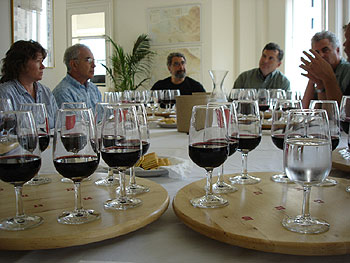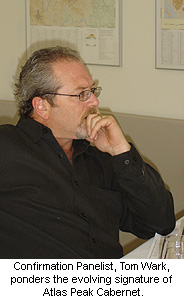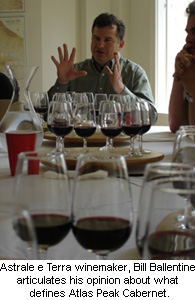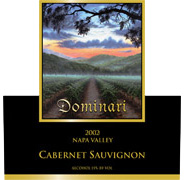Discovery Program

Atlas Peak winemakers gather to taste and discuss
Cabernet’s ascent to the top of the ‘Peak’
Cabernet performs a balancing act on Atlas Peak
by Alan Goldfarb, Napa Regional Editor
“We are getting very, very ripe … but we don’t get raisins. We don’t get dehydration or dimpling. It’s a regional characteristic.”
~ Darren Procsal,
Atlas Peak Vineyards’ winemaker
Signature of the Appellation:
Cabernet Sauvignons from Atlas Peak are typically wines of definitive structure with tannins and acidity consistently being in balance.
see Alan Goldfarb’s supplementing article:
Atlas Peak producers try to shake the Sangiovese Blahs
RECORD OF PROCEEDINGS
Last month, in the downtown San Francisco offices of AppellationAmerica, we assembled our Discovery Panel of Atlas Peak winemakers as well as a Confirmation Panel of other industry professionals (see side panel) to taste and discuss a selection of Atlas Peak Cabernet from the 2002 vintage.
The wines were tasted blind and were scrutinized in three stages:
1.) An independent organoleptic assessment to determine the overall quality and characteristics of each wine;
2.) Group discussion to coalesce and synthesize an appellation identity based on the dominant terroir and stylistic patterns found in the wines;
3.) Identify the “Signature” wines of the appellation by voting (blind) for the wines, if any, that best represent what an Atlas Peak Cabernet Sauvignon should taste like when measured against the findings from Stage 2.
Brief Overview of the Vintage: 2002 Atlas Peak
The 2002 growing season on Atlas Peak came fairly early. There was some slight frost and damage to Merlot early on. Later, there was some Cabernet shrivel due to heat spikes in September and October, but in general conditions were not as hot as what they experienced down on the valley floor. Overall, it was generally mild through the season, cooling down and then lasting through early November.
Analysis of the Technical Data
The following information is a summary of the technical information provided by the wineries for each of the seven wines tasted in the Discovery tasting.
It is also worth noting that only one of the entrants was a producer from outside the Atlas Peak AVA, but had used 100 percent of its fruit from the area. That wine, interestingly, was determined by the panel to be the most anomalous of the flight. Of all the wines tasted, this wine had the lowest pH at harvest (3.48), and lowest at bottling (3.42); and the highest acidity at bottling (0.62).

Highlights of the Discussion
During stage 2 discussion, the Discovery Panel tied the wines together by identifying the common elements of the wines’ terroir, which manifested in Cabernets of definitive structure with tannins and acidity consistently being in balance. This is an attribute not to be taken lightly in this post-phylloxera era which has otherwise produced many wines with high fruit extraction, elevated alcohol levels, and low acidity. In other words, wines that may be out of balance.
Across the board, the panel’s comments on structure went thusly: “medium acidity with moderate tannins”…“bright acidity, balanced tannins”…“tart, lean structure”…“biggest tannins upfront, with acidity second”…“firm but elegant”…“integrated, ripe tannin”… and “good tannin structure but not over-the-top valley floor flabby.”
 That is why Confirmation panelist Tom Wark, the creator of Fermentation Blog (who is also the publicist for Astrale e Terra) posed the question, which set the tone for the discussion:
That is why Confirmation panelist Tom Wark, the creator of Fermentation Blog (who is also the publicist for Astrale e Terra) posed the question, which set the tone for the discussion:
“As people begin to pick higher and higher (Brix levels), how is that going to reflect in the signature of Atlas Peak?” he queried.
Jan Krupp, the owner of Stagecoach Vineyards – the largest parcel on Atlas Peak – and the producer of Krupp Brothers wine (which coincidentally and unbeknownst to him at the time, was named one of the two “Signature” wines of this tasting), predicted: “The wines (in the future from Atlas Peak) will have less pronounced structure but will be richer and riper.”
To which Bill Ballentine, the winemaker at Astrale e Terra immediately disabused him, “The wines will be more multi-dimensional but the structure and fullness will (continue) to dominate.
“That’s the uniqueness of Atlas Peak. It will still have that structure.”
Atlas Peak Vineyards’ Darren Procsal, who with the ‘02 vintage, first began to make wine on Atlas Peak added, “We are getting very, very ripe … but we don’t get raisins. We don’t get dehydration or dimpling. It’s a regional characteristic.”
"Appellation Signature" Wines
Appellation Signature wines are those that the panel believes best typify the region and represent the terroir and/or stylistic identity of Atlas Peak. To qualify for ‘Signature’ standing, a wine must receive at least 4-of-5 Discovery Panelist votes. The following two wines were recognized as Appellation-Signatures and are highlighted with aggregate notes/comments of the panelists.
Cabernet Sauvignons from Atlas Peak are typically wines of definitive structure with tannins and acidity consistently being in balance.
see Alan Goldfarb’s supplementing article:
Atlas Peak producers try to shake the Sangiovese Blahs
Last month, in the downtown San Francisco offices of AppellationAmerica, we assembled our Discovery Panel of Atlas Peak winemakers as well as a Confirmation Panel of other industry professionals (see side panel) to taste and discuss a selection of Atlas Peak Cabernet from the 2002 vintage.
The wines were tasted blind and were scrutinized in three stages:
1.) An independent organoleptic assessment to determine the overall quality and characteristics of each wine;
2.) Group discussion to coalesce and synthesize an appellation identity based on the dominant terroir and stylistic patterns found in the wines;
3.) Identify the “Signature” wines of the appellation by voting (blind) for the wines, if any, that best represent what an Atlas Peak Cabernet Sauvignon should taste like when measured against the findings from Stage 2.
Brief Overview of the Vintage: 2002 Atlas Peak
The 2002 growing season on Atlas Peak came fairly early. There was some slight frost and damage to Merlot early on. Later, there was some Cabernet shrivel due to heat spikes in September and October, but in general conditions were not as hot as what they experienced down on the valley floor. Overall, it was generally mild through the season, cooling down and then lasting through early November.
Analysis of the Technical Data
The following information is a summary of the technical information provided by the wineries for each of the seven wines tasted in the Discovery tasting.
It is also worth noting that only one of the entrants was a producer from outside the Atlas Peak AVA, but had used 100 percent of its fruit from the area. That wine, interestingly, was determined by the panel to be the most anomalous of the flight. Of all the wines tasted, this wine had the lowest pH at harvest (3.48), and lowest at bottling (3.42); and the highest acidity at bottling (0.62).
- Five of the seven wines were comprised of 100 percent Cabernet Sauvignon, while one had in its blend 7 percent Petit Verdot, and another was blended with an indeterminate percentage of Merlot, Cab Franc and Petit Verdot.
- The age of the vines ranged from 3 to 20 years.
- Brix at harvest ranged from 24.5 percent to 26.4.
- All wines went through malolactic fermentation.
- All wines were fermented in French oak, with only one using 100% new wood. The range of used oak was 25 percent to 85 percent.
- The final listed alcohol percentage ranged from 13.95 percent to 14.9.
- The wines ranged in suggested retail price from $38 to $100.

Highlights of the Discussion
During stage 2 discussion, the Discovery Panel tied the wines together by identifying the common elements of the wines’ terroir, which manifested in Cabernets of definitive structure with tannins and acidity consistently being in balance. This is an attribute not to be taken lightly in this post-phylloxera era which has otherwise produced many wines with high fruit extraction, elevated alcohol levels, and low acidity. In other words, wines that may be out of balance.
Across the board, the panel’s comments on structure went thusly: “medium acidity with moderate tannins”…“bright acidity, balanced tannins”…“tart, lean structure”…“biggest tannins upfront, with acidity second”…“firm but elegant”…“integrated, ripe tannin”… and “good tannin structure but not over-the-top valley floor flabby.”
 That is why Confirmation panelist Tom Wark, the creator of Fermentation Blog (who is also the publicist for Astrale e Terra) posed the question, which set the tone for the discussion:
That is why Confirmation panelist Tom Wark, the creator of Fermentation Blog (who is also the publicist for Astrale e Terra) posed the question, which set the tone for the discussion:
“As people begin to pick higher and higher (Brix levels), how is that going to reflect in the signature of Atlas Peak?” he queried.
Jan Krupp, the owner of Stagecoach Vineyards – the largest parcel on Atlas Peak – and the producer of Krupp Brothers wine (which coincidentally and unbeknownst to him at the time, was named one of the two “Signature” wines of this tasting), predicted: “The wines (in the future from Atlas Peak) will have less pronounced structure but will be richer and riper.”
To which Bill Ballentine, the winemaker at Astrale e Terra immediately disabused him, “The wines will be more multi-dimensional but the structure and fullness will (continue) to dominate.
“That’s the uniqueness of Atlas Peak. It will still have that structure.”
Atlas Peak Vineyards’ Darren Procsal, who with the ‘02 vintage, first began to make wine on Atlas Peak added, “We are getting very, very ripe … but we don’t get raisins. We don’t get dehydration or dimpling. It’s a regional characteristic.”
"Appellation Signature" Wines
Appellation Signature wines are those that the panel believes best typify the region and represent the terroir and/or stylistic identity of Atlas Peak. To qualify for ‘Signature’ standing, a wine must receive at least 4-of-5 Discovery Panelist votes. The following two wines were recognized as Appellation-Signatures and are highlighted with aggregate notes/comments of the panelists.
- Dominari
Cabernet Sauvignon, Atlas Peak, 2002: ($75)
Bright, dark, deep color. Rich, sweet, oak vanilla, chocolate, jammy and berry notes, slight celery in the nose. Berry with hints of vanilla flavors and mint-y eucalyptus, blackberry, dark cherry, cedar, brown sugar, cocoa. Big, tannic structure with modest acidity finishing second. Velvet-y. Balance?...Wow! Although it has big tannins, it finishes creamy with nice acidity, lingering but needs time. Best tannins of the flight, which are too much at first, but upon allowing it to sit in the glass, it’s well-integrated.
Technical notes:
Gaudeamus Vineyard. 100 percent Cabernet Sauvignon - Clone 6. 13 year old vines. Elevation






